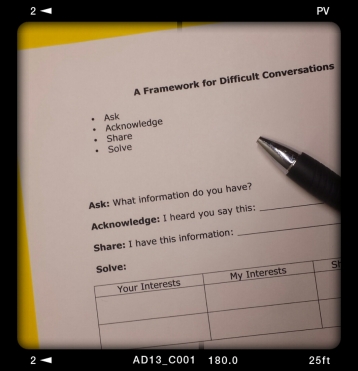
We all think we’re pros.
We’ve been communicating for years, decades, and we’re pretty good at it.
Except when we’re not.
Whether you’d call yourself an expert or you’re just getting started on the journey of better conversations, we all have room to grow.
This is the first in a series of posts (check back for more!) about improving your communications and I’ll cover some of the basics as well as some of the more nuanced, but conversation-saving, elements of connecting with the people around you.
Let’s get started, because where you start really matters.
Think back to your last conversation that didn’t go well.
How did it begin?
You’re probably thinking about what you said (or what they said). The words. How you said them. The background of the whole conversation.
Let me ask a different question: Did you begin already knowing the (right) answer?
We often do, even when we think we’re starting with an open mind.
Beginning with the firm belief that you don’t know the answer is the first key to successful communication.
Most of us are probably already lining up the reasons why that can’t be right. One mouse-click away from jumping to the next article, but really consider that question.
How often do you start an important conversation already knowing what the “right” answer is? Or what the field of “possible” answers looks like? Most of us do this without evening being aware of it.
Obviously, there are times when the right answer really is the right answer. How to sweep a fire extinguisher, the temperature at which water boils. Those aren’t the kinds of conversations or facts that we struggle with.
When you believe that you don’t know the right answer, you make space in the conversation for options. You widen the field. You let other people into the conversation with their perspectives, their knowledge, and their experience.
But what if I do know the right answer.
You don’t.
We are flawed decision-makers. We have a bias towards what we already know, we surround ourselves with information that supports our thinking, and we don’t challenge our opinions or question our own ideas often enough.
(There’s a large body of research on this topic, you can find some of it in the books and sites below.)
You can’t know the right answer until you’ve opened your mind enough to look around. Otherwise, you just know what you think is the right answer and you haven’t done your homework.
If you start your conversation from your answer, it may feel like you’re several steps down the road, saving time and heading toward a better decision, when you’re actually heading off in the wrong direction.
What you need in complicated situations is a deep pool of information to draw from, and you alone don’t have all the information.
Does this mean I have to hide what I know just to make people feel like they’re part of the decision?
No. That’s actually just doing the same thing we’re trying to avoid. Put what you know out there, into the pool, but invite others first, fill it up together before you make your decision.
For example,
If you bring your team together to solve systematic problems – say you’re having routine failures in your ability to deliver products on time – and you know that what’s not working is the supervisors’ oversight of the deadlines, you might focus on that part of the system.
You might argue with me that you know this, because you’ve seen communications between supervisors and their staff. It’s all pretty clear.
Ask yourself: what if you’re wrong?
The cost of beginning with your answer may be missing the critical information that helps you actually solve the problem.
You could begin by assuming that the broken link is in the supervisor-employee communications, alienating everyone in the room in the process.
If instead you begin by sharing what you’ve seen (facts only!) and asking what they know, you may unearth a series of other data points that helps you all see the full picture.
You may learn that there are problems with other parts of the system, or that an earlier production phase isn’t working, leaving your supervisor-employee team scrambling to make up time at the cost of quality.
If you don’t ask, you won’t know.
Learning to make space for new information will improve the decisions you and your team make.
Key take-aways
If you hear yourself beginning a conversation with any of these red-flag phrases, pause, reframe, and invite others into the pool of information:
“I think we should…..”
“The way to solve this problem is….”
“What if we did……”
“We’ve already done this so……” (sets you up to continue a pattern or build on past decisions)
Consider these as alternatives:
“How may ways could we…..”
“Are there ways to achieve multiple goals here…..”
“What are the options we have used before and what haven’t we used…..”
“What are we trying to achieve (not how)….”
“If someone new walked in the door, what do you think they would do……” (opens up options beyond what you’ve already done)
For more about the pool of information idea, read Crucial Conversations by Patterson, Grenny, McMillan, Switzier
For better decision-making, try Decisive by Dan and Chip Heath
For why starting with being right doesn’t work, consider Better Leaders, Better Teams by Roger Schwarz
Check back or sign up for notifications if you’d like to receive more tips to improve your communications.




